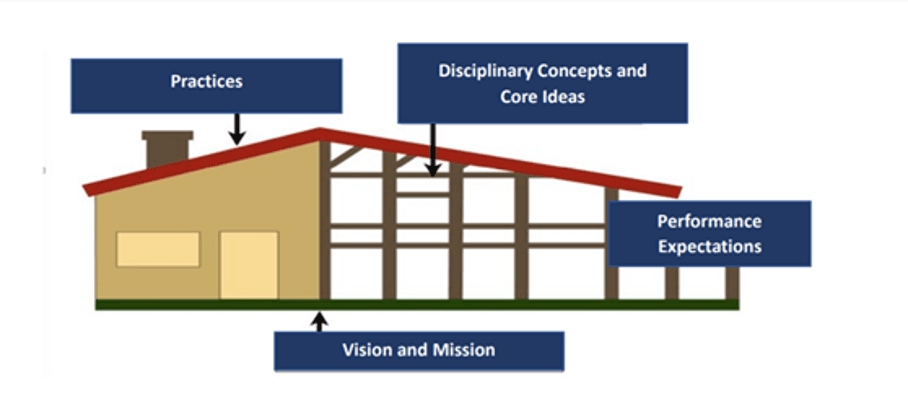
NJSLS Career Readiness, Life Literacies and Key Skills (2020), p 3
Vision and Mission = Foundation of each content area’s standards Disciplinary Concepts & Core Ideas = The Joists; makes connections among the Performance Indicators and helps teachers prioritize Performance Expectations = The Studs; serve as the framework of what students should know and be able to do Practices = The Roof; aka: the top, the apex of learning. Helps students internalize the Habits of Mind and apply them to new situations. (NJDOE, 2020) Subject-Specific Look-fors: In addition to these key considerations below, we have created subject-specific webinars dedicated to unpacking and understanding these updates. Click the links beside each title for a deeper dive into each set of standards!View all the subject-specific recorded webinars here
Science While the NJSLS Science Standards continue to reflect a cohesive applicability to Next Gen Science Standards (NGSS), it’s important to note the addition of the scaffolded Climate Change standards. This includes setting the stage for students to think critically about climate change, the ways to positively impact climate change - and to promote climate action. Prioritizing climate issues into the standards is a critical way to emphasize the topic’s importance and its integration into units of instruction. It’s also significant to note: Climate change standards have been integrated across multiple content areas. In addition, the new science standards place a greater emphasis on the inclusion of local and global problems, the ways in which personal and societal issues impact the field of science and vice versa, along the intersection of science and civic life. World Languages The World Language Standards changes underline the importance of multiculturalism and diverse language acquisition. It's not a matter of rewriting curriculum, but refining curriculum. One of the other changes to notice is the difference in language around assessing proficiency versus assessing performance. Several of the content areas have updated with a focus on proficiency. The state describes one such difference as it is reflected in the World Language Standards: “Performance is defined as how well a learner uses language acquired in a classroom setting; Proficiency is defined as the spontaneous use of language in real-world situations that might occur…” A new Proficiency Level was also added: Novice Low. Classrooms will also explore and address social justice issues in local and global communities. Career Readiness, Life Literacies and Key Skills Formerly known as the 21st Century Life and Careers, the new Career Readiness, Life Literacies, and Key Skills Standards are designed to build communication and collaboration in an interconnected global economy. The hope is that students will learn more than just the checks and balances of managing money, but also the psychology of spending and saving - key opportunities for greater nuance and understanding, leading them to well-informed career and financial decisions. The standards also speak to the importance of being able to pivot…to have a career plan and goals, but alter those plans based on societal changes. Section 9.4- Life Literacy and Key Skills is new. This section has been added to “ensure our students are prepared with the necessary knowledge, skills and dispositions to thrive in an interconnected global economy.” (Career Readiness, Life Literacies and Key Skills, 2020, p 3) Visual & Performing Arts NJ DOE describes the importance of a “well-designed, sequential arts program” (Visual & Performing Arts, 2020, p1). Part of the shift in design involves embracing the Core Arts Standards and those practices. The goal is to work from an artistic process perspective and develop artist literacy and fluency. The DOE has created and integrated New Media Arts Standards- intended to amplify and integrate the four traditional art disciplines, as well as music being broken into specific sections to include Composition & Theory, Ensembles, Harmonizing Instruments and Music Technology. One other aspect of the state’s vision for creating a robust VPA program is the focus on “new artistic work (that is) reflective of a variety of ethnic, racial and cultural perspectives.” (Visual & Performing Arts, 2020, p1). The Arts program, like Science, has also included opportunities to inform and address climate change issues. Finally, if you are still looking for a deeper dive into understanding the changes made to the NJSLS standards, we have created subject-specific webinars dedicated to unpacking and understanding the updates. We’ll also be bringing you more blogs this fall focused on Social Studies, Computer Science & Design Thinking, and Comprehensive Health & Physical Education, along with more webinars in January to explore the remaining standards releases. Moving Forward with your Curriculum Writing? After identifying key changes and additions to look for in the standards, it’s time to start working through next steps for alignment. If your school is using Atlas or Atlas Next, you’ll have the benefit of accessing the new standards in your curriculum mapping system, to create new alignments, add assessments, while building your units of instruction. While each subject area varies in some of its specific components, we have suggested next steps to get you going! Here is a helpful checklist for Science:Explore our NJ PD offerings and let us know how we can support you with implementing the 2020 NJSLS!
What’s Next? We’ll also be bringing you more blogs this fall focused on Social Studies, Computer Science & Design Thinking, and Comprehensive Health & Physical Education, along with more webinars in January to explore the remaining standards releases. Stay tuned! Register for the NJSLS webinars here! The Author An ardent believer in the value of lifelong learning, growth, and knowledge share, Sarah has collaborated with Atlas schools for over ten years, providing support and expertise on their standards alignment and analysis process, advising on best practices, and supporting schools through workshops, writing, and education research. Sarah enjoys speaking with teachers and administrators directly, to build understanding about their schools curriculum process and learning target needs.
She also conducts copyright research and works with national and international education organizations to gain permission for, and understanding about, the sets of standards third party organizations such as NCCAS, WIDA, C3, and State Departments of Education can provide to best support schools who are mapping with Atlas. Sarah earned her Bachelor’s degree in Speech Communication and her Master’s in Interdisciplinary Studies (MAIS), both from Oregon State University. Her MAIS focused within the Speech Communication and MBA programs.
She has eight years of experience teaching Communication courses in higher education. Sarah has also taught persuasion and public speaking to grade school students, and has been an Art Literacy teacher in her local elementary school the last seven years. A fan of the oral and written traditions of story telling, Sarah believes there is great value in continually building and honing one’s listening and speaking skills.
An ardent believer in the value of lifelong learning, growth, and knowledge share, Sarah has collaborated with Atlas schools for over ten years, providing support and expertise on their standards alignment and analysis process, advising on best practices, and supporting schools through workshops, writing, and education research. Sarah enjoys speaking with teachers and administrators directly, to build understanding about their schools curriculum process and learning target needs.
She also conducts copyright research and works with national and international education organizations to gain permission for, and understanding about, the sets of standards third party organizations such as NCCAS, WIDA, C3, and State Departments of Education can provide to best support schools who are mapping with Atlas. Sarah earned her Bachelor’s degree in Speech Communication and her Master’s in Interdisciplinary Studies (MAIS), both from Oregon State University. Her MAIS focused within the Speech Communication and MBA programs.
She has eight years of experience teaching Communication courses in higher education. Sarah has also taught persuasion and public speaking to grade school students, and has been an Art Literacy teacher in her local elementary school the last seven years. A fan of the oral and written traditions of story telling, Sarah believes there is great value in continually building and honing one’s listening and speaking skills.
